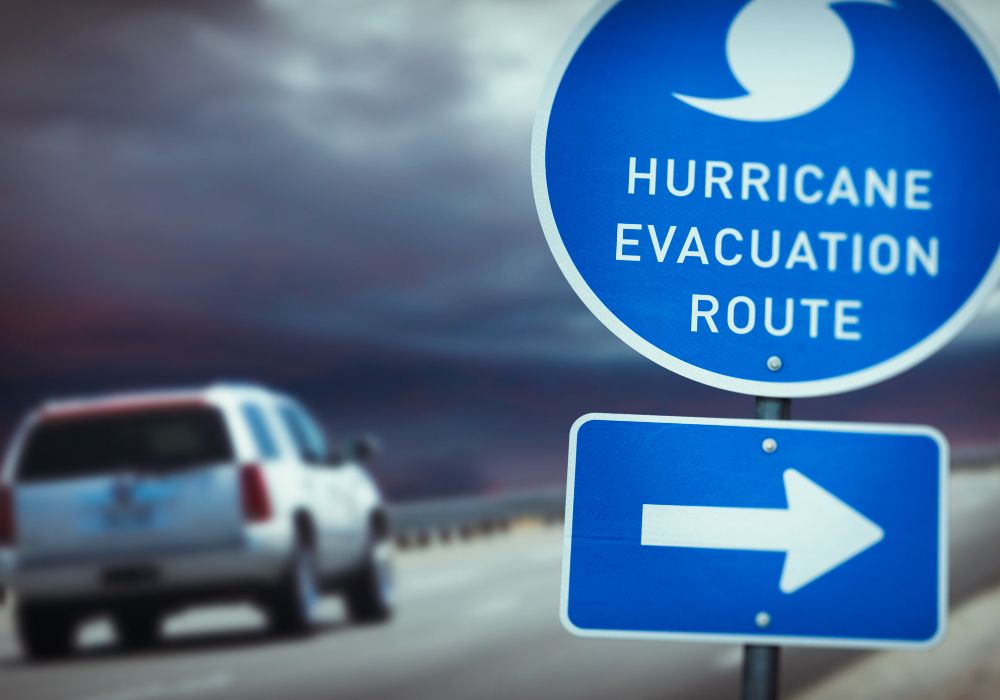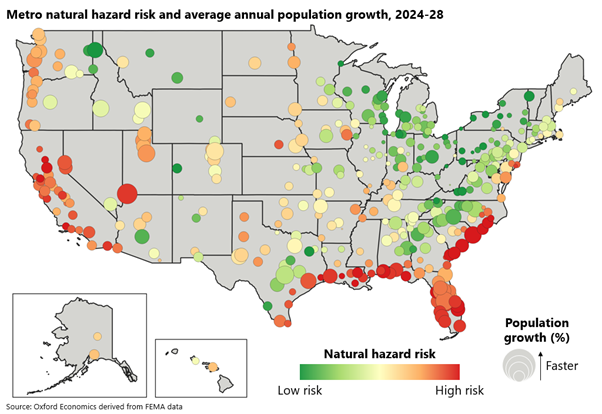Americans are flocking to metros with a high risk of natural disasters


- Heatwaves, hurricanes, and other natural hazards have increased in frequency and intensity in the US as the effects of climate change have grown.
- Our research has found that instead of moving away from the riskiest regions of the country, people continue to move into metros with high climate-related risks, including Houston, Orlando, and Myrtle Beach.
- Conversely, relatively “safer” metros will experience less population growth over the medium term. We anticipate net out-migration in some of the lowest-risk metros, including in Chicago and Cleveland.
Heatwaves, hurricanes, and other natural hazards have increased in frequency and intensity in the US in recent years—most recently evidenced by the back-to-back hurricanes of Helene and Milton that pummeled Florida and other parts of the South—putting more and more people in harm’s way. And whereas we might expect people to be moving out of the riskiest regions of the country, we have found the opposite to be true: people continue to move into high-risk areas. Five of the six fastest-growing metros in terms of population in 2023 were in Florida, and cities in South Carolina, Alabama, and Texas also landed in the top 10, highlighting the broad appeal of the southern US. This population growth is largely due to in-migration. The region has experienced strong economic growth in recent years, and research shows that economic motives often dominate migration decisions, in addition to affordability, desire for more space, and quality of life. Yet migration trends suggest that many people are not currently taking into consideration climate risks or natural hazards when choosing where to relocate.
The same southern metros that are attracting new residents due to their economic opportunities are also the ones more likely to be significantly affected by natural hazards. But this isn’t a story of just a few cities.
Using FEMA’s National Risk Index, we estimate the share of every US metro’s economy expected to be lost on an annual basis due to 18 unique natural hazards. We classify each metro in one of three groups: the bottom third as “low risk”, the middle third as “moderate risk”, and the top third as “high risk”. In 2023, the population growth rate of high-risk metros was 35% higher than the growth rate of low-risk metros. The chart below shows that in aggregate, people moved to high-risk metros at a faster rate than to moderate- or low-risk metros.
Hover over the chart to check the value
This worrying trend is expected to continue in the medium term
We forecast that many of the fastest-growing metros in the period to 2028 will be located along the southern coast, continuing the trend of the past few years. Yet several of these cities, including Houston, Orlando, Myrtle Beach, Lakeland (FL), and The Villages (FL), rank among the most at-risk metros for economic disruption caused by natural hazards. Houston alone will add over half a million new residents, despite the multiple high-profile natural disasters that have occurred in recent years, including Hurricane Harvey in 2017, the severe winter storms in 2021, and recent flooding from storms in May. And several metros in Florida have among the fastest population growth over the medium term, even though the state has experienced several major hurricanes (and associated storm surges, flooding, and tornados) in recent years—from Irma in 2017, to Ian in 2022, to Helene and Milton in a recent two-week period in 2024. Hurricanes have battered Florida to such an extent that the state’s coastline is changing.

The continuation of this trend is particularly worrying because many (although not all) of the natural hazards included in our analysis are linked to climate change and are expected to increase in severity and frequency in the coming years. These climate hazards include hurricanes (a significant driver of risk on the southern coast), wildfires (California), and droughts (countrywide).
Conversely, “safer” metros will experience less population growth
The upper Midwest and the Rust Belt are home to many metros that have much lower natural hazard risks. But these relatively safe cities are forecast to experience much less in-migration over the medium term, continuing a trend of the past few years.
In some cases, we anticipate net out-migration from these metros, including in some of the largest ones in the region: Chicago and Cleveland. Cities across the region have been struggling economically in recent years, which explains why people are moving out in search of job opportunities (and why others aren’t moving in). Of the top 10 metros with the lowest risk of economic disruption from natural hazards, half of them will experience net out-migration over the next five years.
Unlock exclusive economic and business insights—sign up for our newsletter today
Clearly, people are prioritizing other factors (such as the economy) over natural hazard risks when deciding where to relocate, and we expect this trend to continue over the medium term. However, over the longer run, as climate risks become more acute, they may take on a larger role in people’s migration decisions.
Relatedly, some insurance companies have already abandoned certain states and metros due to their growing exposure to catastrophes. For homeowners, access to (affordable) insurance will likely factor into decisions about where to live in the future as well, even if it hasn’t yet to a significant degree. At the same time, we also assume that many state and local governments will increase their climate adaptation and mitigation efforts in the coming years, which could provide improved protection against some of the worst natural hazard risks. But for now, the uncomfortable truth is that as climate-related dangers intensify, Americans are continuing to flock to the metros facing the highest risks.
The analysis and forecasts in this blog are backed by our US States and Metro Service and our City Climate Scenarios Service. To discover how we can help you make data-driven, locally tailored, climate-related decisions with confidence, click here to request a demo.
Subscribe to our newsletters
Subscribe to our newsletter to get our insights straight to your inbox. Additionally, you can check ‘Talk to us’ box to have our team contact you about a free trial of our services and how we can support you.
Tags:
Related Reports

The Economic Impact of SHEIN in the United States
Consulting Report Americans are flocking to metros with a high risk of natural disasters You might be interested in
Find Out More
Which regions are most exposed to the 25% automotive tariffs?
While the automotive tariffs will likely lead to some production being reshored to US plants, they will also raise costs for US manufacturers and households.
Find Out More
US wealth effects are packing a larger punch than ever
Wealth effects proved to be a quite reliable tailwind to consumer spending this cycle.
Find Out More
Tariffs 101: What are they and how do they work?
Tariffs are taxes imposed by a government on goods and services imported from other countries. Think of tariff like an extra cost added to foreign products when they enter the country. They’re usually a percentage of the price of the goods, making imported items more expensive compared to domestically produced good
Find Out More